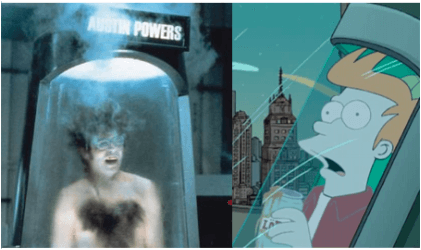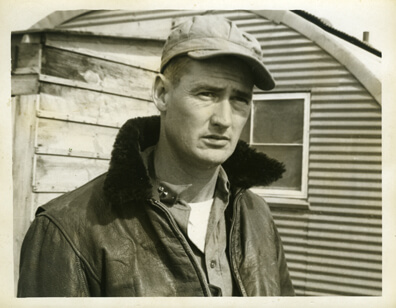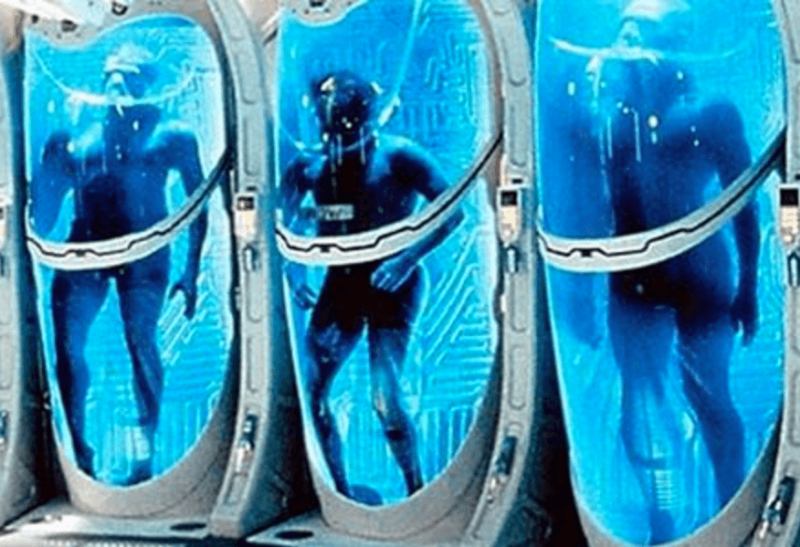Cryonics… just hearing the word stimulates discussion and debate surrounding the evolving definition of clinical death and also evokes images of famous and not-so-famous people making a last ditch effort to achieve something that is mostly still science fiction.
Cryonic preservation (maintaining a body at very cold temperature in hopes of someday reviving the individual after medicine has advanced to the point of curing his/her ailment) is performed on humans, only after they have been declared legally dead. It has been criticized as a kind of New Age religion that gives people false hope in technology the way that many traditional religions have provided false hope in theology; both offer a kind of afterlife with no evidence that anybody has ever achieved it.
But saying mostly still science fiction constitutes an important distinction. The hit TV series, Star Trek The Next Generation, found a way to criticize cryonics while at the same time imagining a creative scenario in which three cryonically preserved people from the 20th century got really, really lucky and woke up in the 24th (season 1, episode 26: The Neutral Zone). Cryonics had existed for a couple of decades when the episode aired in 1988, but the writers set the time of the characters’ preservation 10 years later—the late 1990s. This freed the writers from the criticism that anyone preserved was profoundly unlikely to be revivable by future technology, because better preservation techniques could be around the corner. That is logical and, in fact, cryonicists actually have been implementing increasingly better techniques over the years.
Generally, experts in neuroscience, biomedical engineering, and nanotechnology regard cryonics as a pseudoscience. To be sure, some of the most widely popularized criticism against cryonics, such as that freezing the body would produce ice crystals that would destroy the cellular integrity of the brain is not valid at the present time. Since the first cryonic preservation in 1967, cryonics companies — the main one in the United States is Alcor Life Extension Foundation, located in Scottsdale, Arizona — have been updating their preservation techniques, and so the basic cryonic strategy today is not freezing, but vitrification. As explained on the Alcor website:
Vitrification is an ice-free process in which more than 60% of the water inside cells is replaced with protective chemicals. This completely prevents freezing during deep cooling. Instead of freezing, molecules just move slower and slower until all chemistry stops at the glass transition temperature (approximately -124°C). Unlike freezing, there is no ice formation or ice damage in vitrified tissue. Blood vessels have been reversibly vitrified, and a whole kidney has been recovered and successfully transplanted with long-term survival after vitrification at a temperature of -135°C.
The preservation of function of a vitrified whole kidney of a rabbit is substantiated in peer-reviewed studies, such as this one in the journal Organogenesis. The hypothesis — the hope for those opting for cryonics — is that by avoiding disruption of the relative positioning between cells that comprise tissues, vitrification will work for the entire body, particularly the brain enough to preserve the self awareness of the individual. That latter part is the mystery and has no basis in the peer-reviewed literature thus far, because proving it would require vitrifying and rewarming a live human being (completely unethical), or at least a large mammal such as a dog or pig.

But as expressed in a recent article in the prestigious MIT Technology Review, the unscientific nature of cryonics in its present form has a lot to do with the fact that we don’t know enough yet the neurologic basis of consciousness to be able to preserve it. For this reason, better preservation does not necessarily mean adequate to enable reanimation at a later date, and so anyone who opts for cryonic preservation is opting into something that is unproven.
This criticism notwithstanding, it is important to keep in mind that the market for cryonics today is quite small. As of 2014, the total number of people in cryonic preservation in the U.S. was roughly 250. It includes some famous individuals, such as baseball hero Ted Williams, but it’s hardly an expanding cultish movement that threatens society, and someday this handful of individuals may be remembered as pioneers, even if science is never able to revive them. Moreover, it’s very important to separate cryonics as practiced on a handful recently-deceased people from the science of cryobiology whose discoveries cryonicists are attempting to utilize.
Science fiction or science fact?
How close is cryonics from transitioning from science fiction to medical reality? What is the state of the science of cryobiology as it relates to the extension of life and health? The answer to the second question goes back almost a century when pioneers of blood banking realized that keeping donated blood samples cold could extend blood viability substantially. Consider how many lives blood banking and transfusion have saved over the years, and what medicine would be without it. Consider how the same idea of using cold temperature was applied to preservation of various drugs and antisera, and later applied to donated whole organs so they could be transported between cities, and you’ll appreciate that advances in cryobiology already have had a profound effect on extending life and health.
Because vitrification also involves cooling, cryobiologists have been investigating it and refining it with new techniques and chemical solutions, which has led to advances like the rabbit kidney preservation described above. Each time that cryobiologists report success in low temperature preservation of tissues and organs in peer-reviewed journals, such as Cryobiology, cryonicists take notice. That’s what led them to replace freezing with vitrification, and while that’s jut one step, recently vitrification hit a new milestone.
In December 2015, a team led by Robert L. McIntyre at 21st Century Medicine in southern California published a paper in Cryobiology describing the successful preservation of microstructure of whole rabbit brains vitrified with a technique called aldehyde-stabilized cryopreservation (ASC) and kept at -135°C. After rewarming of the brains and removal of cryoprotectant chemicals, examination with focused ion beam milling and scanning electron microscopy (FIB-SEM) demonstrated traceable anatomic processes and preserved synapses between the neurons. In other words, the microscopic anatomic structure on which memory, and ultimately consciousness, is thought to depend was not disrupted.
This is not proof that cryonic preservation using something like ASC vitrification would work, but it’s a step in that direction. According to the nonprofit Brain Preservation Foundation, which rewarded the 21st Century Medicine Team, the next logical step should be to demonstrate the same thing in brains of larger mammals, such as pigs.

That’s where the science stands right now. If it works with pig brains, a later step might be to ASC vitrify an entire small mammal within a minute or two after cutting off circulation to the brain, then rewarm and see whether the animal can be revived and whether there is brain damage. It might take a while to reach this step, but eventually, new discoveries from cryobiology may just lead to a form of cryonics that can be validated, first in small mammals, then dogs and pigs, and finally humans. At that point, there would be a major ethical issue, because if it’s going to work on people who cannot be resuscitated with current-day medicine, first it must work on healthy people.
Therein lies the rub, but we’re not there yet anyway. In the meantime, as with blood banking and organ donation, cryobiology is once again poised to extend life, this time by advancing organ preservation. The same vitrification approach used on the rabbit brains and the transplanted functional rabbit kidneys could be used on human kidneys, corneas, livers, hearts, and other organs. That’s where the research is heading, because with standard organ preservation, the temperature is lowered, but it remains above freezing point. This puts a limit of few hours to a couple of days from removal to implantation, depending on the organ.
For a heart, the limit is only four to six hours, so geographic distance between potential recipients and donors has a major influence on the organ matching process and transportation logistics are vital. It does not allow banking that has been in place for many decades for blood products and that is emerging for bone marrow products. If we could do that with organs, average lifespan would be increased by several years and more people would reach a very old age, and that should interest anyone who is considering cryonics.
Cryopreservation versus suspended animation
In parallel with advances in organ preservation, advances in low temperature medicine are coming into the clinical realm. Suspended animation refers to the slowing or complete stopping of life processes without stopping life. It already has transitioned from science fiction to science fact in various clinical and research settings. The most futuristic such setting is clinical research centered on application of induced profound hypothermia — intentionally lowering a patient’s body temperature to just a few degrees above the freezing point — to extend the amount of time that the brain can stay healthy without perfusion of oxygenated blood from a few minutes to two to three hours, perhaps a bit more.
Known as Emergency Preservation and Resuscitation for Cardiac Arrest and Trauma (EPR-CAT), the technique under study is to be applied to victims of trauma with severe blood loss. In that type of setting two to three hours of suspended animation would be extremely helpful for saving lives, but it’s plausible that incremental improvements in EPR-CAT and other techniques can lead to a capability for suspended animation lasting many hours, days, weeks, and even many months. This could be applicable to various medical conditions, and eventually even to spaceflight. However, it does not offer the promise of indefinite suspension, as cryonics enthusiasts seek to do, because the temperature remains above freezing temperature.
To consider stasis for centuries or millennia to allow emergence of medical technologies to reverse conditions that are now incurable, that takes much lower temperatures. From this standpoint, advances in suspended animation, such as EPR-CAT are not at the point where we could say that they’re part of the science that could enable cryonics. But often, science and medicine have made leaps as a result of advances in more than one field coming together.
David Warmflash is an astrobiologist, physician and science writer. Follow @CosmicEvolution to read what he is saying on Twitter.































